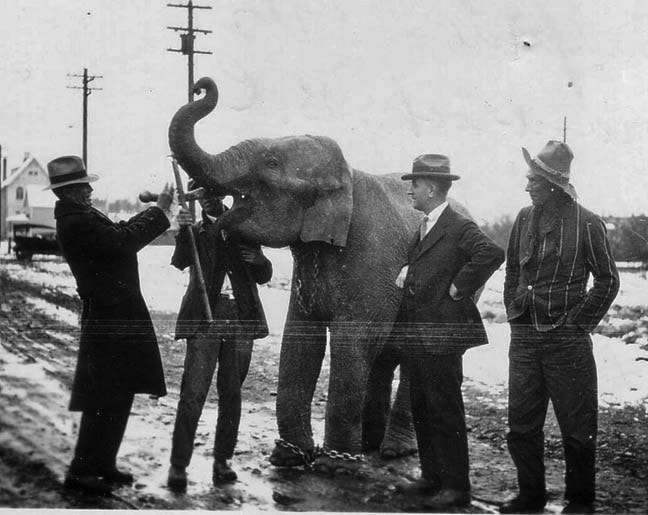Two weeks after three elephants stampeded from Cranbrook rail yards on August 6, 1926, two of the pachyderms are still at large.
By September 2, Myrtle is known to be hiding in dense timber near the base of Moyie Mountain. Charlie Ed hasn't been seen for three weeks. The weather is starting to turn and things are looking grim for the pair.
On September 8, an exhausted, barely alive Myrtle is captured on Moyie Mountain. The Herald reports that she had fallen over a 40-foot cliff and was suffering from pneumonia.
The Courier simply says she is a “physical wreck”. She has lost all of her toenails, her knees are “fearfully bruised” and she has two bullet wounds in her hip, reportedly shot by a local Myrtle charged in her fear.
When elephant trainers approached the poor little elephant, she didn’t startle. Local people rushed food and bedding to Myrtle, but by the time they arrived, she had already died. Later, circus officials said they had put her out of her misery.
Unable to be moved, Myrtle’s body remained at the spot for almost a year. At first, local men used her as bait for game hunting. “Elephant meat is good for bait” reported the Courier at the end of September, adding that one man shot a massive grizzly at the sights.
“The trophy which Mr. Gray brought in from the wilds is in splendid peltage, and the huge claws and tusks of the animal are perfect.”
Hoping to preserve Myrtle’s remains for science, A.J. Ironside and a Courier newspaperman head out to Moyie Mountain, and bring back Myrtle’s head and one of her front feet. They are sent to the University of Alberta in Edmonton, where they remain even now, in the 21st century. The following July, a scientific expedition from the university, led by a Courier staff member, return and collect the rest of Myrtle’s bones.
A piece of Myrtle’s hide, one-inch square and fastened with twine, is these days in the possession of the Cranbrook Archives.
Meanwhile, near Lumberton, Charlie Ed is faring much better. But Cranbrook’s Fall Fair is approaching, and the circus has offered that if the little trick elephant can be captured before September 16, Cranbrook can put him on show at the fair.
So a crew of locals and circus men come up with a plan. They have found the watering hole where Charlie Ed comes to drink. So they set up a snare, strung from a couple of tamaracks, and they wait.
Soon enough, on September 14, Charlie Ed happens upon it, is caught up, and finally lets the handlers chain his feet.
Unlike poor Myrtle, Charlie Ed is in pretty good shape and, according to the Courier on September 16, “seems to have thrived on native grasses and leaves in his weeks of roaming the jungles of Canada”.
The little elephant is slowly but triumphantly led back into town, taking a full day to get from Jimsmith Lake to town.
The very next day, a snowstorm hits Cranbrook. It certainly would have killed the Indian elephant.
So what happened to Charlie Ed when he returned to Cranbrook? That’s a story for tomorrow’s Townsman.
